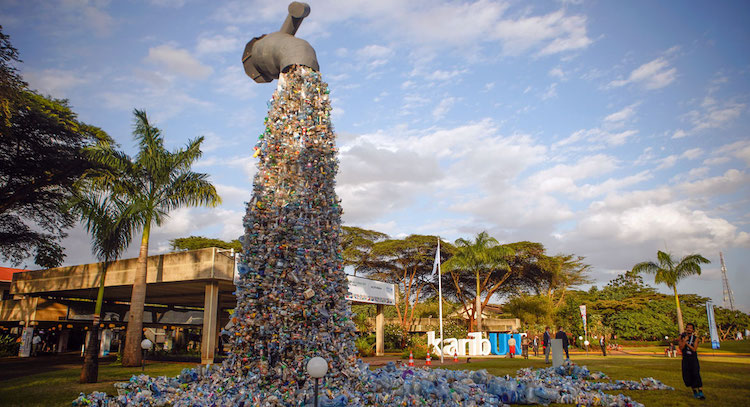By Thalif Deen
UNITED NATIONS (IDN) — In the 1967 Hollywood box office hit “The Graduate”—a romantic comedy directed by Mike Nichols and based on a novel by Charles Webb—the newly-graduated Dustin Hoffman gets an unsolicited piece of advice: “The future is plastics”.
The widely disseminated one-liner was hailed as a boost for the world’s plastic industry. But 55 years later, the industry is under fire because of the environmental hazards it generates. FRENCH | ITALIAN | JAPANESE | TURKISH
A proposed legally-binding international treaty on plastics, which is expected to be finalized by 2024 by the UN Environment Assembly (UNEA), will have a significant impact on the worldwide industry because it is expected to cover the full life cycle of plastic—from production to pollution.
The treaty holds the potential and the promise of being the “biggest multilateral environmental breakthrough” since the 2015 Paris climate agreement, said Inger Andersen, executive director of the United Nations Environment Programme (UNEP) based in Nairobi.
“What we need is an international framework that aims to end the flow of plastic into nature by 2030, aligns with the best available science and holds governments and businesses to account.”
According to the Washington-based Center for International Environmental Law (CIEL), “pollution from plastic production, use, and disposal is one of the greatest human-made threats our planet faces”.
Of the approximately 415 million metric tons of plastic waste produced annually, nearly 80% is either landfilled or loose in the environment, and another 12% is incinerated or burned, wreaking havoc on livelihoods and ecosystems.
The result is an estimated $13 billion in annual environmental damage to marine ecosystems, in addition to other economic losses and significant health and human concerns, said CIEL in a statement released last month.
According to CIEL, plastics begin as fossil fuels, and every step of the plastics life cycle emits greenhouse gases. If plastic production and use grow as currently planned, by 2030, the greenhouse gas emissions along the plastics life cycle could reach 1.34 gigatons per year.
By 2050, the cumulation of these greenhouse gas emissions from plastics could reach over 56 gigatons—10-13 percent of the entire remaining carbon budget. The increase in plastic production and consumption threatens the global community’s ability to limit global temperature rise to 1.5°C.
On March 2, the Fifth United Nations Environment Assembly (UNEA) concluded with the historic passage of a mandate to advance the treaty, plus the establishment of an Intergovernmental Panel on Chemicals, along with a wide variety of measures to address chemicals and waste.
Participating in the Assembly were Heads of State, Ministers of environment and representatives from 175 nations
The mandate contains first-ever protections for human rights, recognition for waste pickers, and the acknowledgment of the role of Indigenous peoples.
At the conclusion of the negotiations, Andrés Del Castillo, Senior Attorney at CIEL, said coming out of UNEA, “we have a mandate that can serve as a meaningful scaffolding for a legally-binding instrument on the full life cycle of plastics, that pays special attention to the marine environment”.
“With detailed, specific provisions throughout the mandate, we have the ingredients to craft a treaty that is comprehensive in scope and that sufficiently addresses the plastic crisis”.
But the ninety hours of hard-fought negotiations also reveal that the road ahead will not be simple or easy—there is still much to be done to ensure that the resulting treaty delivers on its promises for health, climate, biodiversity, and human rights,” he told IDN.
Asked if the treaty will have to go before the 193-member UN General Assembly for final approval, he said: “No, normally, it will be necessary for a diplomatic conference, where plenipotentiaries will adopt the legal instrument”.
According to CIEL, the plastics crisis is inherently transboundary, with supply chains crossing borders and the impacts of pollution extending to every region of the planet and nearly every facet of human life.
Given the unique nature of the crisis, a concerted and coordinated global response is required to address it adequately and mitigate the harms currently inflicted on people and environments from the overproduction, toxic footprint, and misuse of this material.
The current legal regime addresses some elements of plastic pollution, but it is fragmented, with elements focusing on some portions of marine litter, fishing gear, waste, and chemicals, all existing parallel to one another, said CIEL.
“The structure lacks coherence and coordination between measures that address plastic pollution on land and at sea, and there are significant gaps in regulations and control across sources of pollution from the full life cycle of plastics.
To prevent pollution from plastics, the global community urgently needs a dedicated instrument—a new plastics treaty—that aims to reduce or eliminate harms from the entire life cycle of plastics, from production and design to waste prevention and management”.
At the conclusion of the negotiations on March 1, David Azoulay, Senior Attorney, Director of Environmental Health programme, said the historic nature of the mandate cannot be understated.
Six years ago, he said, a legally binding treaty that addresses the full life cycle of plastics seemed impossible and today’s announcement is the result of multiple movements coming together to understand and address an emergency.
“The power of this movement is evident in what we’ve been able to accomplish together. And coupled with the commitments expressed by countries such as Peru, Rwanda, Norway, and the European Union, to ensure we have a sufficient response to the plastics crisis is nothing short of extraordinary”.
“Now, as we turn to negotiate a plastics treaty, we must continue to work together to ensure that the most robust protections for health, climate, biodiversity, and human rights are not watered down or undermined by Parties or industry,” he declared. [IDN-InDepthNews — 11 March 2022]
Photo: A 30-foot-high monument entitled ‘Turn off the plastics tap’ by Canadian activist and artist Benjamin von Wong stands outside the venue for the UN Environment Assembly that concluded on March 2, 2022 in Nairobi, Kenya. Credit: UNEP/Cyril Villemain




